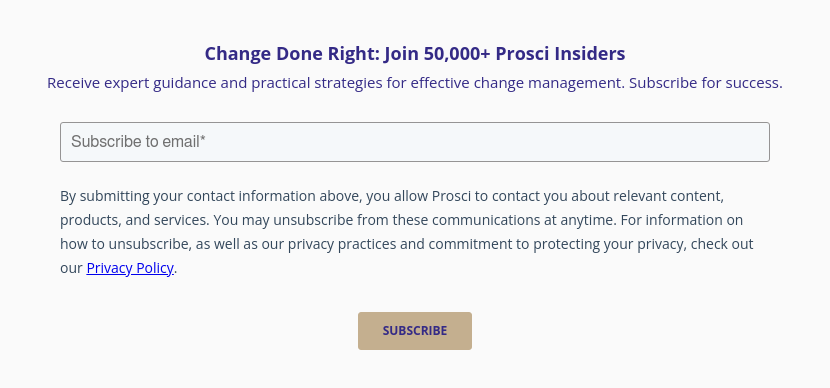

Change management comes to life through change management plans. The objective of the plans is to support impacted individuals and groups to move through their ADKAR journeys effectively and enable them to adopt and use a change. Practitioners develop change management plans during Phase 2 of the Prosci 3-Phase Process.

The Prosci 3-Phase Process
The Master Change Management Plan is the deliverable from Phase 2 – Manage Change. It describes the high-level blueprint and specific plan or plans to be developed for the change project, including the actions, roles and timelines to prepare, equip and support people to achieve their ADKAR transitions.
Before developing any specific change management plan, change practitioners create an ADKAR Blueprint to set the direction for a change initiative. The ADKAR Blueprint is a simple and scalable guide, oriented toward people, which enables the practitioner to identify at a high level the milestone dates, expected gaps and initial ideas for each ADKAR element.
Under some circumstances, such as small, low-risk changes, the ADKAR Blueprint may be all that is needed. Or, if you’re a novice practitioner, the ADKAR Blueprint may be all you feel confident developing for your change. For more complex, higher-risk projects, however, the ADKAR Blueprint serves as a starting point to help you identify, scale and develop a set of robust change management plans to meet the needs of your specific project.

The core change management plans are the specific, high-value plans recommended for most change initiatives. Designed to be scalable and flexible to your situation, they can be role-based or activity-based:
While the ADKAR Blueprint addresses all elements of ADKAR, each core change management plan includes tactics to address certain ADKAR elements. Again, you may or may not need all four core plans. The number, type and depth of plans required depend on the project as well as the organization’s unique needs.
Effective sponsorship is consistently cited as the top contributor to project success in every Prosci Best Practices in Change Management benchmarking study. Unfortunately, even the best senior leaders sometimes do not demonstrate effective sponsorship. They may misunderstand the importance of their role, struggle with competing priorities, or simply not know what to do. To ensure successful sponsorship, the change practitioner must provide the needed support and structure, and enable sponsors to execute their employee-facing responsibilities.
The Sponsor Plan is a recommended core role plan to target the Awareness, Desire and Reinforcement elements of the ADKAR Model. This change management plan, implemented by the primary sponsor and other members of the sponsor coalition, enables them to effectively carry out their roles—to be active and visible, build a coalition of support, and communicate directly with employees.
As “people managers,” middle managers and supervisors directly impact front-line employees because these employees will typically emulate their manager’s attitudes about the change, whether those attitudes are supportive or not.
A recommended core role plan, the People Manager Plan targets all elements of the ADKAR Model. This plan, carried out by people managers, enables them to effectively perform their CLARC roles:
The People Manager Plan outlines the steps for involving managers in these change management activities. The plan starts by laying out how the project team and change management resources will build commitment, and train and prepare managers and supervisors for their role in a change. Once on board, managers and supervisors work with front-line employees to understand their needs and help them adopt and use changes.
People often mistakenly equate change management with communication. While many organizations have communications departments and many project teams create communications plans, they often fail to recognize how communication fits into the broader change process. Communication is a critical component of implementing change but is by no means the only requirement for success.
A recommended core activity plan, the Communications Plan targets the Awareness and Reinforcement elements of the ADKAR Model. The Communications Plan identifies audiences, develops key messages, and determines the frequency of communications, delivery mechanisms, and senders.
Note that effective communication does not mean an attractive newsletter, the use of a standard template, or even a high frequency of messages. Effective communication is targeted for each of the different audiences impacted by the change and focuses on what they care about and what they need to know. A structured communication plan presents the right messages at the right time, in the right format or via the right channel, and from the right sender.
Absent a holistic approach to change management, organizations sometimes use training alone to manage changes without critical activities like sponsorship and coaching. This is one of the biggest errors a team can make when introducing a change and a prime example of poor change management.
A recommended core activity plan and one of the most-used change management plans, the Training Plan targets the Knowledge and Ability elements of the ADKAR Model. The plan is created by identifying the different audiences that need training, conducting a needs assessment and gap analysis, and documenting requirements for the training organization.
In addition to project-specific training, it is important to include training about change management in this plan. Sponsors and people managers need training to understand their important roles and responsibilities in managing change.
When change management is applied effectively, a partnership forms between the change management team (which documents knowledge needs) and the training group (which develops and delivers the needed training).

The Sponsor Plan has the highest impact on Awareness, Desire and Reinforcement while the People Manager Plan influences all five ADKAR elements. The Communications Plan primarily impacts Awareness and Reinforcement. The Training Plan serves primarily to enable Knowledge and Ability.
“Extend” Plans are the potential additional plans you may decide to include in your Master Change Management Plan to address issues that are unique to your change.
Resistance to is a natural reaction to change and is consistently cited as a top obstacle to success in Prosci research. Sponsors and people managers can take meaningful steps early in a project to mitigate potential impacts through resistance prevention.
An extend activity plan that may be created during Phase 2 – Manage Change, the Resistance Management Plan targets the Desire element of the ADKAR Model by preventing, addressing and responding to resistance. The plan identifies potential sources and forms of resistance, steps to answer objections before they manifest, who will be involved in managing resistance, and how you will prepare them to effectively address the resistance.
A complete resistance management plan will also include steps for monitoring and responding to resistance, including identifying triggers and taking appropriate actions.
You may decide you need additional change management plans to meet the specific requirements of your change. Such plans can be completely unique to your change and organization, or they may resemble the typical extend plans below.
Every change initiative needs a combination of plans, and the right combination depends on your needs. The Prosci Methodology encourages change practitioners to take a flexible approach to developing change management plans based on numerous factors including the risk level of the change, culture of the organization, and the practitioner’s change management competency level. These factors influence which plans to choose—whether the ADKAR Blueprint alone or some other combination of core and extend plans—to support your work and success with change.

Lisa Kempton is Prosci Director of Global Learning Products. She has been helping organizations excel at change for more than 20 years. She is best known for her work in collaboration with Tim Creasey to build and develop the Prosci Change Scorecard – a holistic, research-based tool to bring clarity, alignment and credibility to the Change Management process. Previously, as a senior consultant and change leader in the healthcare, insurance, IT, and utilities industries, Lisa led large-scale strategic transformations, established a Change Management practice and infrastructure, designed organizational effectiveness solutions, and more.
See all posts from Lisa Kempton